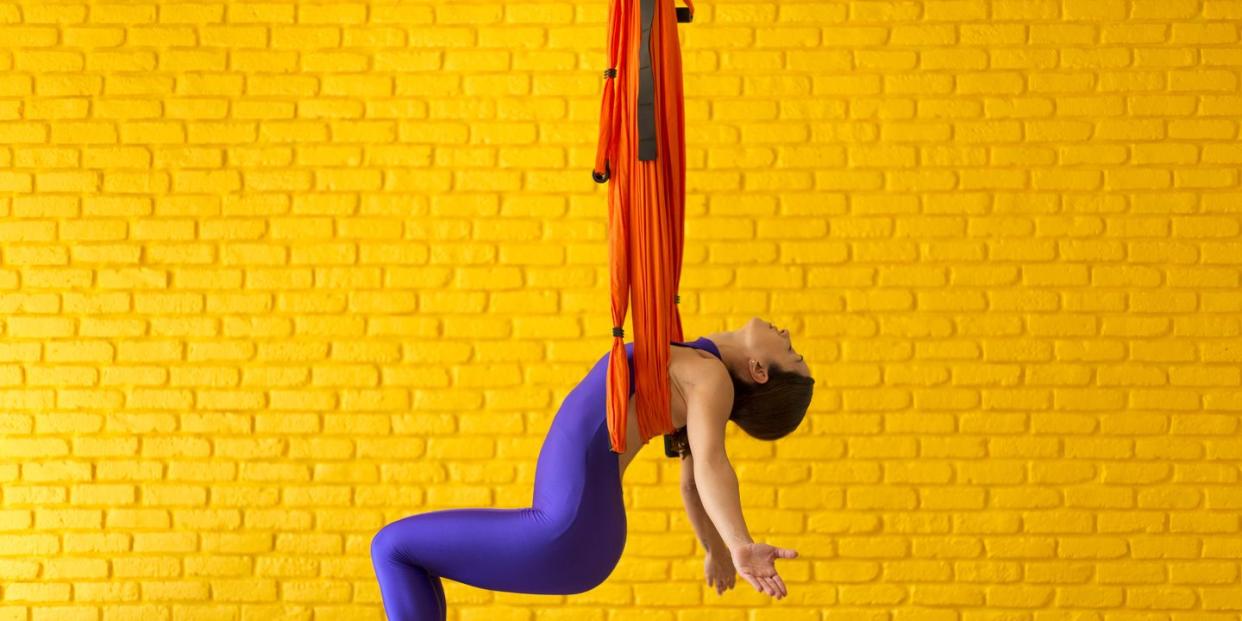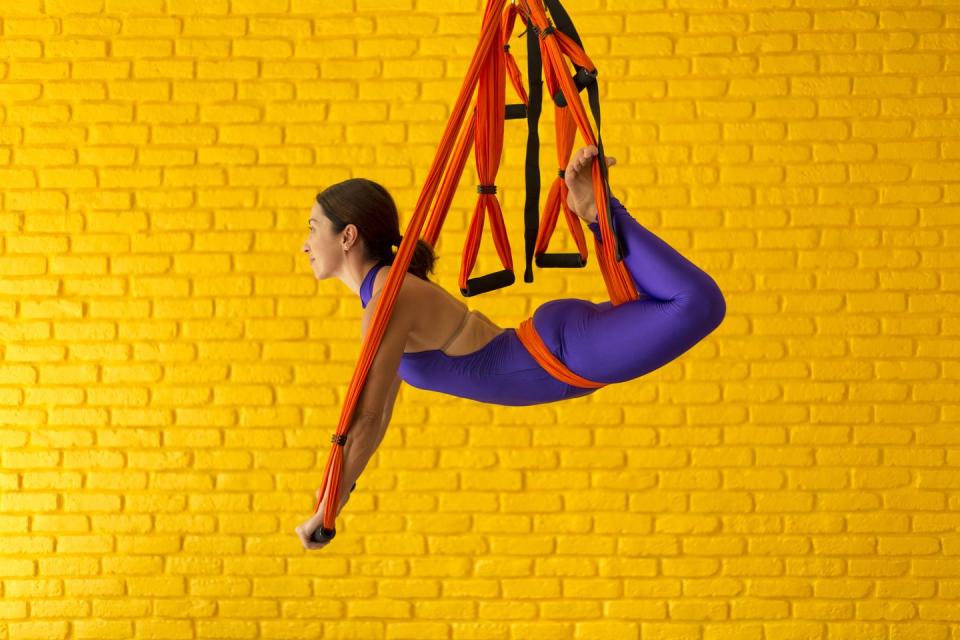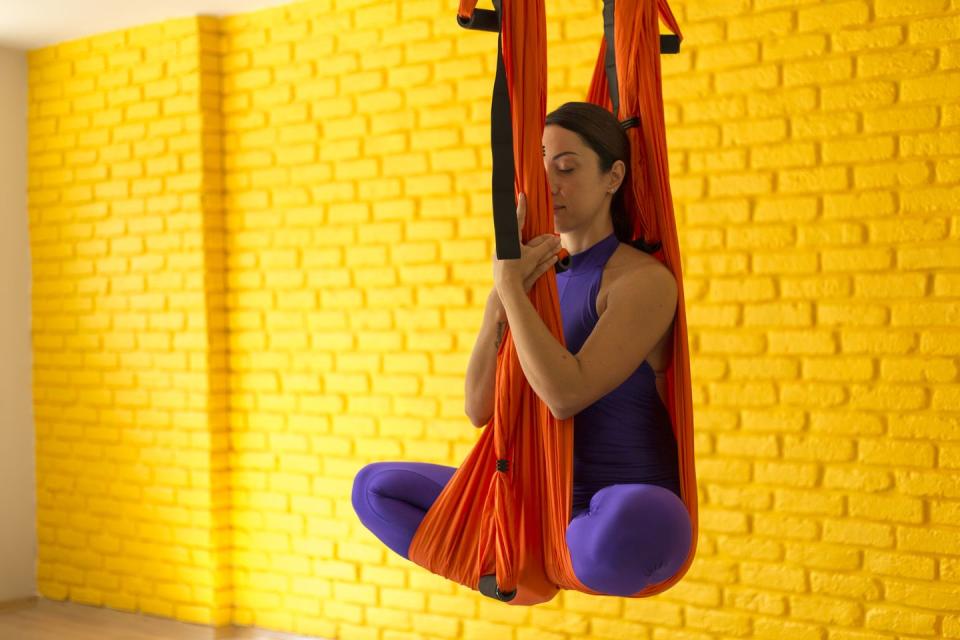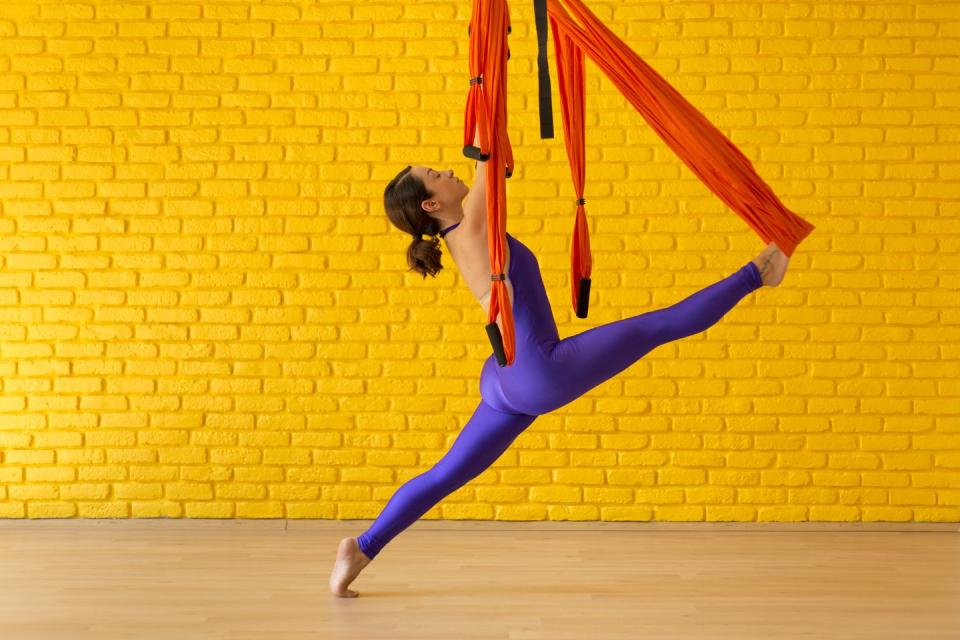Your Complete Guide to Aerial Yoga for Beginners

Yoga has been the most popular virtual class booked on the Mindbody fitness service app this year, making up 32% of virtual bookings with an average of nearly 22,000 yoga bookings per day. But not every class requires you to get on a mat. In fact, if you're a fitness enthusiast, you may have seen beautiful Instagram-worthy shots of a different type of yoga that defies gravity.
Aerial yoga is quickly gaining popularity worldwide and provides a slew of physical and wellbeing benefits. We chatted with top aerial yoga instructors to find out everything you need to know before heading to your first class.
What is aerial yoga?
Instead of performing yoga poses on a mat, aerial yoga utilizes a silk hammock or sling that is suspended from the ceiling to perform those same movements. The purpose of the hammock is to provide support through your yoga flow, while also improving flexibility and range of motion. The hammock also takes pressure off certain areas of the body like the head and shoulders, allowing you to reach those more challenging poses like headstands with greater ease. Although most aerial yoga photos you'll find seem to showcase a yogi fully suspended in air, many aerial yoga poses only require you to take one body part such as your foot or leg off the ground.
Aerial yoga for tips for beginners:
If you're new to aerial yoga fitness, Michelle Li, Co-Owner of AIR Los Angeles and AFTT Certified Aerial Yoga Instructor, says that you can expect a fun and transformative experience. But, the practice can definitely be challenging and your body might need some time to calibrate. Li says that you don't have to have any prior yoga experience to take an aerial yoga class, but being well versed in floor yoga beforehand can certainly be beneficial. Here are some tips to remember before you head to your first class:
Trust the sling: "This is a body-inclusive practice, as the sling can hold up to a couple thousand pounds. No matter your shape, size or ability, you can enjoy aerial yoga," says Mindbody Holistic Wellness Expert and Certified Yoga Instructor Dani Schenone.
Wear the right gear: For an aerial yoga class, you'll want to wear tight yoga pants or leggings as opposed to loose pants or shorts, says Lea Walker, Owner of Aeriform Arts, Levity Aerial Yoga Certified and Grounded Aerial Bungee Certified Instructor. A sports bra is needed, as well as a fitted workout shirt that ideally covers the underarms if you have sensitive skin as the slings can sometimes cause chafing. Walker also suggests wearing a tank top and bringing a long sleeve shirt with you to wear for some of the moves.
Don't eat a big meal beforehand: You'll want to avoid eating a large meal for at least an hour before class, but Walker also notes that you don't want to go into the class with low-blood sugar, so a small snack like a banana beforehand should be fine.
Leave the jewelry at home: Schenone says that jewelry can get easily snagged in the slings, so it’s best to be jewelry-free during your practice.
Just relax: Walker adds that the more difficult moves can be intimidating and people can often get in their own head. Breathe through the poses and go at your own pace.
Speak up: If you need help handling the sling, or you’re uncomfortable in a pose, Schenone and Walker both agree that you shouldn't be afraid to speak up and ask the instructor for help. That is what they are there for, and they want you to enjoy yourself during the class.
Modify when necessary: Walker stresses that even though a movement may look difficult, there are tons of modifications that make aerial yoga classes accessible to anyone. Go into the class with an open mind and make sure you have an open communication line with your instructor.

Physical benefits of aerial yoga:
Increase full-body flexibility and strength: Schenone says that this practice is a full-body type of movement, so it strengthens all muscles. The hammock itself allows you to go deeper into the stretches and poses, further enhancing full-body flexibility.
Alleviate back and neck pressure: Li says that sitting or standing all day long allows gravity to weigh down the spine, but being upside down in certain aerial yoga moves she claims can help lengthen and decompress the spine.
Promote circulation: Given the nature of the poses and breathing through the movements, Li says that aerial yoga is great for promoting circulation throughout the body as well as digestion.
Improve core strength: In order to maintain stability throughout the different poses, Li says that it's important to keep the abdominal muscles engaged throughout the practice.
Boost confidence and mood: In addition to the opportunity to learn something new, Schenone says that aerial yoga makes more advanced yoga poses accessible to beginner yogis by the support of the sling which can boost confidence in the practice and provide a sense of accomplishment.
Low-impact exercise: Because of its low or zero-impact nature, Schenone says that aerial yoga is an excellent option for those who want to move their bodies, but experience joint issues. Using gravity and suspension, aerial yoga allows practitioners to create space in the body without compressing the joints. There are even joint-relief-focused aerial yoga classes that specifically target joint pressure and pain.

Aerial yoga poses:
Some aerial yoga poses require only a bit of support from the hammock for balance purposes, while others require you to place 100% of your bodyweight on the sling itself. A beginner or introductory class can get you well-versed in basic wraps and poses. Some of Schenone's favorite aerial yoga poses include:
Vrksasana (tree pose): This pose is excellent for individuals with tight hips and anyone who has a hard time with external rotation of the hips. Your body is supported by the sling, making it a more restorative variation of the posture.
Matsyasana (supported fish pose): This is an accessible pose that is great for people with different abilities, and it opens the chest and aids in spinal mobility.
Ardha Kapotasana (half pigeon pose): Your bent leg is on the ground, and your lengthened leg is in the sling. This pose helps open up the hip flexors.
Supta Konasana (reclined angle pose/inverted star pose): Getting your heart above your head is so beneficial – yes, you are upside down for this one, but it can be done!
Aerial yoga classes to check out:
Li teaches at AIR Los Angeles and Walker teaches at Aeriform Arts in Los Angeles as well. Here are some examples of studios where you can book aerial yoga via Mindbody:

Is it safe to do aerial yoga at home?
Li says that many companies sell free-standing rigs that you can place in your backyard to do aerial yoga, but she advises to avoid hanging one in your home unless done by a professional since indoor setups can damage your ceiling and also can be very dangerous if done improperly. Walker does not recommend home aerial yoga unless you are keeping a grounded base, which means at least one foot on the ground for the movement. If your heart is set on buying an aerial yoga hammock and installation set, Walker suggests investing in a top quality brand. You can also look up local studios and see if you can get in for a one-on-one session. Whether you try your first aerial yoga class tomorrow or a year from now, go in with an open mind and make the most of it.
You Might Also Like


